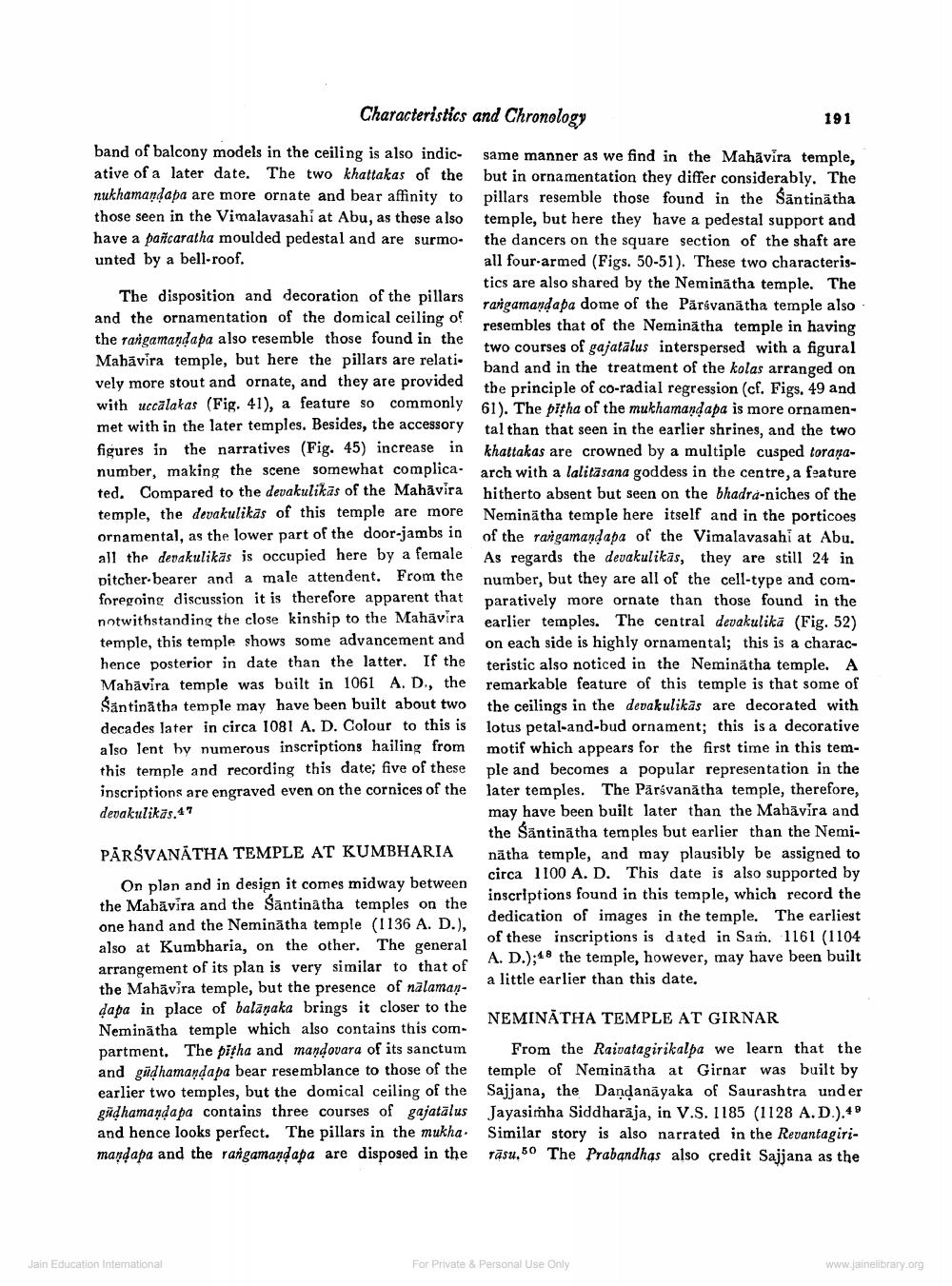________________
Characteristics and Chronology
191
band of balcony models in the ceiling is also indic- same manner as we find in the Mahavira temple, ative of a later date. The two khattakas of the but in ornamentation they differ considerably. The nukhamandapa are more ornate and bear affinity to pillars resemble those found in the Säntinātha those seen in the Vimalavasahi at Abu, as these also temple, but here they have a pedestal support and have a pañcaratha moulded pedestal and are surmo- the dancers on the square section of the shaft are unted by a bell-roof.
all four-armed (Figs. 50-51). These two characteris
tics are also shared by the Neminātha temple. The The disposition and decoration of the pillars
Tarigamandapa dome of the Pārsvanātha temple also and the ornamentation of the domical ceiling of
resembles that of the Neminātha temple in having the rangamandapa also resemble those found in the
two courses of gajatalus interspersed with a figural Mahāvira temple, but here the pillars are relati
band and in the treatment of the kolas arranged on vely more stout and ornate, and they are provided
the principle of co-radial regression (cf. Figs. 49 and with uccalakas (Fig. 41), a feature so commonly 61). The pitha of the mukhamaydapa is more ornamenmet with in the later temples. Besides, the accessory tal than that seen in the earlier shrines, and the two figures in the narratives (Fig. 45) increase in khattakas are crowned by a multiple cusped torananumber, making the scene somewhat complica arch with a lalitasana goddess in the centre, a feature ted. Compared to the devakulikās of the Mahāvira hitherto absent but seen on the bhadra-niches of the temple, the devakulikās of this temple are more Neminätha temple here itself and in the porticoes ornamental, as the lower part of the door-jambs in of the rangamandaba of the Vimalavasahi at Abu. all the devakulikäs is occupied here by a female As regards the devakulikas, they are still 24 in pitcher bearer and a male attendent. From the number, but they are all of the cell-type and comforegoing discussion it is therefore apparent that paratively more ornate than those found in the notwithstanding the close kinship to the Mahavira earlier temples. The central devakulikā (Fig. 52) temple, this temple shows some advancement and on each side is highly ornamental; this is a charachence posterior in date than the latter. If the teristic also noticed in the Neminätha temple. A Mahāvira temple was built in 1061 A. D., the remarkable feature of this temple is that some of Šantinátha temple may have been built about two the ceilings in the devakulikās are decorated with decades later in circa 1081 A. D. Colour to this is lotus petal-and-bud ornament; this is a decorative also lent by numerous inscriptions hailing from motif which appears for the first time in this temthis temple and recording this date; five of these ple and becomes a popular representation in the inscriptions are engraved even on the cornices of the later temples. The Pärsvanatha temple, therefore, devakulikās. 47
may have been built later than the Mahavira and
the Sāntinātha temples but earlier than the NemiPĀRSVANATHA TEMPLE AT KUMBHARIA
nātha temple, and may plausibly be assigned to
circa 1100 A. D. This date is also supported by On plan and in design it comes midway between
inscriptions found in this temple, which record the the Mabăvira and the Sāntinatha temples on the
dedication of images in the temple. The earliest one hand and the Neminātha temple (1136 A. D.),
of these inscriptions is dated in Sam. 1161 (1104 also at Kumbharia, on the other. The general
A. D.);48 the temple, however, may have been built arrangement of its plan is very similar to that of the Mahavira temple, but the presence of nalaman
a little earlier than this date. dapa in place of balanaka brings it closer to the
NEMINĀTHA TEMPLE AT GIRNAR Neminātha temple which also contains this compartment. The pitha and mandovara of its sanctum From the Raivatagirikalpa we learn that the and güdhamandapa bear resemblance to those of the temple of Neminätha at Girnar was built by earlier two temples, but the domical ceiling of the Sajjana, the Dandanayaka of Saurashtra under gūdhamandapa contains three courses of gajatālus Jayasimha Siddharāja, in V.S. 1185 (1128 A.D.). 4° and hence looks perfect. The pillars in the mukha. Similar story is also narrated in the Revantagirimandapa and the rangamand apa are disposed in the rāsu,50 The Prabandhas also credit Sajjana as the
Jain Education International
For Private & Personal Use Only
www.jainelibrary.org




